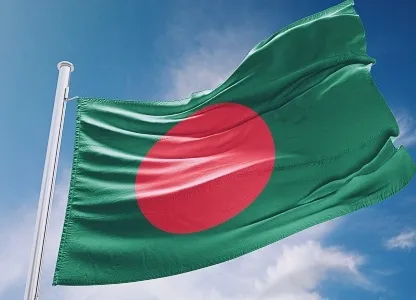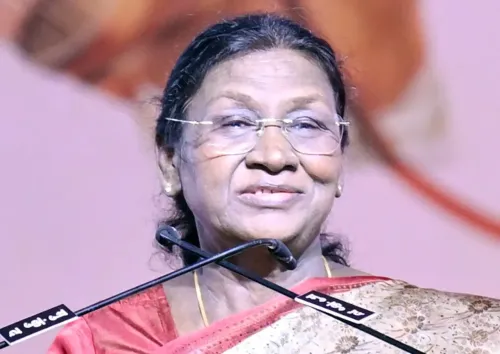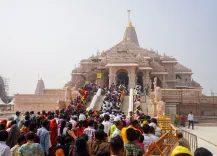Bangladesh: What Lies Beneath the New Political Order and the Rise of Fascist Forces?

Synopsis
Key Takeaways
- Political unrest in Bangladesh has intensified following Sheikh Hasina’s removal.
- The National Citizen’s Party has emerged as a significant force amidst the chaos.
- The Gopalganj incident highlighted the troubling dynamics of the current political order.
- Concerns about the erasure of Sheikh Mujibur Rahman’s legacy are growing.
- Democratic principles are at risk as political factions vie for dominance.
New Delhi, Aug 3 (NationPress) The political landscape of Bangladesh has always been lively, yet its vibrancy is frequently overshadowed by episodes of violence that seem almost woven into its history. Following the removal of Sheikh Hasina from power in August of last year, the nation has spiraled into a state of unrest, where chaos reigns and ordinary citizens are increasingly impacted by escalating insecurity.
The interim administration, while publicly committed to restoring order, appears either unable or reluctant to tackle the growing disorder.
With the Awami League banned and absent from the electoral process, a void has formed that does not lead to stability.
Political tensions have intensified, with former allies now pitted against each other in a fragmented political landscape.
Among the contenders, the National Citizen’s Party (NCP), born from last July’s student protests, has surged as a significant and contentious force. Its rapid rise has heightened tensions in a nation still wrestling with the legacy of its previous ruling party.
The incident in Gopalganj on July 16 starkly highlighted the troubling aspects of this new political order.
The NCP’s ambitious nationwide campaign, titled “March to Build the Country,” was meant to commemorate the first anniversary of the July Uprising.
What began as a demonstration to promote unity quickly devolved into violence, as NCP members clashed with elements of the banned Bangladesh Chhatra League—the former student wing of the Awami League.
Reports confirmed the use of crude explosives, leading to five deaths and over 50 injured. Although the Awami League is officially disbanded, its grassroots presence and legacy are evidently persistent.
More troubling is the NCP’s own drift towards authoritarianism. The party, which has long advocated for the banning of the Awami League and labeled its supporters as 'fascists', now exhibits the very characteristics it once criticized.
The violence in Gopalganj—a town historically linked to Sheikh Mujibur Rahman—was no coincidence.
The NCP’s deliberate choice of location is perceived by many as an attempt to tarnish Mujib’s legacy, raising fears of a concerted effort to erase Bangladesh’s historical and ideological foundations.
In recent months, the NCP has taken the lead in national discussions, pushing for three main objectives: a permanent ban on the Awami League, completion of the July Uprising trial, and formal adoption of the July Charter as a foundational document.
The interim government initially resisted these demands. The chief adviser even stated that it was up to the Awami League to decide on electoral participation.
However, following the NCP’s May rally in Dhaka, the government altered its stance. The League’s registration was annulled by the Election Commission on May 12, halting all its political activities pending the results of the July trials.
The international community reacted unfavorably to this decision, with numerous observers criticizing it as a deviation from democratic principles.
The banning of the nation’s oldest and most historically significant political party has raised concerns about the interim government’s impartiality and the future of pluralistic politics in Bangladesh.
While the NCP characterizes the Awami League as fascist, it is becoming increasingly clear that the new party harbors its own ideological extremism.
The attack on Mujibism is now more than mere rhetoric. There is a systematic effort to eliminate the legacy of Sheikh Mujibur Rahman—Bangabandhu, the Father of the Nation—from public consciousness.
Since Hasina's removal, state-led initiatives have facilitated the removal of his portraits, the cancellation of holidays celebrating his accomplishments, the renaming of institutions, the alteration of textbooks, and even the destruction of historical sites associated with him.
This transformation transcends politics, extending into a cultural revolution aimed at redefining the ideological landscape of the nation.
The existing Constitution, established in 1972 with secular and nationalist ideals derived from the Liberation War, is under siege. The NCP, supported by Islamist factions, has denounced it as a ‘Mujibbadi’ document, calling for the eradication of its fundamental principles.
This demand challenges the very essence of Bangladesh’s struggle for freedom and its nation-building efforts.
The interim government’s complicity is hard to overlook. Instead of acting as an impartial steward of national stability, it has quietly facilitated these actions.
The symbolic erasure of Mujib's legacy is glaringly evident in the destruction of sites like Mirza Alam Chattar in Jamalpur and the Bangabandhu memorial in Jessore—both replaced by monuments honoring the July Uprising.
These actions have drawn strong condemnation, with citizens, historians, and civil society leaders cautioning against rewriting history to fit the narrative of a single political faction.
Nowhere is this more evident than in Gopalganj, the birthplace and burial site of Sheikh Mujibur Rahman.
The NCP’s choice to hold a rally there was widely deemed provocative. Eyewitnesses and media reports indicate that NCP members, some armed, unleashed violence on civilians, allegedly with the support of military personnel deployed for crowd control.
The involvement of the Bangladesh Army in the crackdown has raised significant concerns regarding its neutrality. The UK-based International Crime Research Foundation has called for a UN-led investigation into what it describes as a “premeditated assault” on the mausoleum of Bangladesh’s founding father.
The interim government’s silence on the Gopalganj incident speaks volumes, with many interpreting it as tacit endorsement of the NCP’s radical agenda. Nahid Islam, the NCP’s convenor, has made increasingly incendiary remarks since the incident—labeling Gopalganj a “fascist stronghold” and even asserting that Ziaur Rahman, rather than Mujib, was the genuine proclaimer of Bangladesh’s independence.
Such comments not only distort historical truths but also seek to reshape the collective memory of the nation.
Thus, the political violence in contemporary Bangladesh is not merely a consequence of power struggles. It is deeply intertwined with an orchestrated campaign to dismantle Sheikh Mujib’s ideological legacy.
The NCP's insistence on an Awami League-free Bangladesh undermines the tenets of inclusive democracy. Regardless of how discredited a party may seem in public perception, genuine democratic practice necessitates accommodating all voices, including dissenting and unpopular ones.
The tragedy in Gopalganj has unveiled a harsh reality: in the pursuit of eliminating one form of political dominance, Bangladesh risks succumbing to another—this time cloaked in the rhetoric of revolutionary justice and popular sentiment.
However, such a trajectory jeopardizes not only state stability but also the moral integrity of its political landscape. Erasing history, however flawed, is not a pathway to authentic reform.
In today’s Bangladesh, the distinctions between victim and aggressor, fascist and liberator, are increasingly obscured.
If the nation is to break free from this cycle of polarization and purges, it must reaffirm its dedication to truth, reconciliation, and political pluralism—before another chapter of its history is inscribed in blood.









